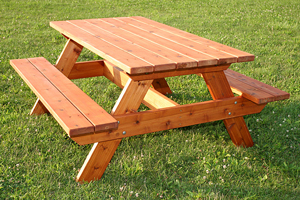
I am planning to build a picnic table, and I was interested in your advice on what kind of wood would be the best. I was researching red oak, but that is rather hard to find in anything other than random widths and lengths, and also it is quite heavy. I also considered American cypress lumber, but I wasn’t sure what a reasonable price per board foot is. A lumberyard advised me to use treated Southern pine. I wasn’t quite sure if I wanted treated lumber or not, but he said that should work fine if it is dried. I would appreciate knowing what your opinions are on these woods and also if you have any other reasonable priced, durable options. – Leslie J. Martin
Rob Johnstone: The traditional woods used for picnic tables are commonly found, weather-resistant softwood species. As your question implies, geography comes into play to certain degree. Here in the frozen north, cypress a really great outdoor wood is not at all easy to find, whereas in Louisiana, it’s as common as a crawfish boil. Red cedar, redwood and Douglas fir are great choices for picnic tables. You would not even need to apply a finish to those species if you did not want to do so. (Although I would recommend “packing” any end grain that will have constant contact with the ground with a wiped-on coat of epoxy. It will add years to the life of the table.) Southern yellow pine is a good choice, and if it is longleaf pine, it does not need to treated to be weather-resistant. (And you can probably find good quantities of it in Pennsylvania at reasonable prices.)
You can use hardwood species like white oak, Spanish cedar, true mahoganies and teak. All will hold up well in weather, but with the exception of the Spanish cedar, they are dense woods that are quite heavy. Depending on your situation, that can be either good or bad, but you should be aware of it.
So the answer to your question, my advice as to which species of wood to use would vary a bit depending on where you live, how the table will be used and stored and what kind of finish you may or may not be planning on using. But if I was to make a picnic table for my backyard, I’d go with clear Douglas fir, pack the end grain and apply low-cost penetrating deck finish.
Chris Marshall: I would steer clear of using treated wood for furniture that will rub up against bare fingers, forearms, thighs and the like, and here’s my unscientific rationale for why: in my experience, slivers from treated lumber are extremely painful. Being in good company, we can all relate to the usual amount of pain that goes along with the typical benign splinter, but there’s something about treated wood that makes the pain even worse. It’s a burning sensation, and I can only surmise it has to do with the treating chemicals. Again, this is just conjecture on my part, but I won’t build outdoor furniture from treated lumber for that reason — it’s just not worth the potential pain. I prefer to use Western red cedar for outdoor projects, because I think it smells great, and it’s naturally decay and insect resistant. It’s also plentiful at the local big box stores and contractor-type lumberyards where I live.





